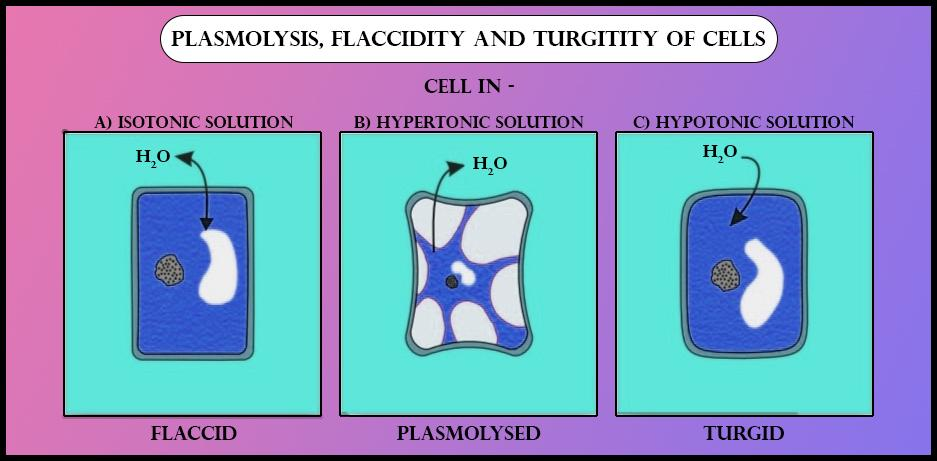
Plasmolysis occurs due to
(a)Exosmosis
(b)Endosmosis
(c)Presence of solutes
(d)Semipermeability of the cell membrane
Answer
479.7k+ views
2 likes
Hint: The process in which the cells lose water in the hypertonic solution is known as plasmolysis. Plasmolysis occurs when the cell is in a hypotonic solution which results in lower external osmotic pressure and the net flow of water passes into the cell.
Complete answer:
Plasmolysis occurs due to Exosmosis in which the water molecules move from the region of higher concentration to the region of lower concentration of the cell around the surroundings through the cell membrane. When the cell is kept in a hypotonic solution which is a solution with a higher solute concentration the cell shrinks. When the plant cell enters in a hypotonic solution it absorbs water by the process of an osmosis and the volume of the water increases in the cell that increases the pressure which makes the protoplasm push against the cell wall. This condition is known as turgor where the plant cells are pushed against each other in the same way and resist other water entry to a certain point which is known as full turgor. Plants stand upright due to the turgor in the plants which pushes them and stops the plant cell from bursting. It provides stiffness to the plant as the plant would fall under its weight if its stiffness is lost. The cell starts declining the turgor pressure when there are no air spaces around it and it leads to the greater osmotic pressure which is of the cell.
Additional information:
A plant loses i5s turgor pressure and water when it is placed in a hypertonic solution it loses by plasmolysis through which the pressure decreases to the point where the protoplasm of the cell gets away from the cell wall. It leaves a gap between the cell wall and the cell membrane which makes the plant shrink and crumble. This continuous decrease in pressure leads to the complete collapse of the cell wall which is known as cytorrhysis.

So, the correct answer is 'Exosmosis'.
Note: Plasmolysis was coined by de Vries who determined a plant's agar pressure in his invention using the hypertonic solutions. During incipient plasmolysis, the plasma begins to receive from the completely relaxed cell wall when plasmolysis occurs in a sufficiently concentrated solution of suitable agents such as cane, sugar etc.
Complete answer:
Plasmolysis occurs due to Exosmosis in which the water molecules move from the region of higher concentration to the region of lower concentration of the cell around the surroundings through the cell membrane. When the cell is kept in a hypotonic solution which is a solution with a higher solute concentration the cell shrinks. When the plant cell enters in a hypotonic solution it absorbs water by the process of an osmosis and the volume of the water increases in the cell that increases the pressure which makes the protoplasm push against the cell wall. This condition is known as turgor where the plant cells are pushed against each other in the same way and resist other water entry to a certain point which is known as full turgor. Plants stand upright due to the turgor in the plants which pushes them and stops the plant cell from bursting. It provides stiffness to the plant as the plant would fall under its weight if its stiffness is lost. The cell starts declining the turgor pressure when there are no air spaces around it and it leads to the greater osmotic pressure which is of the cell.
Additional information:
A plant loses i5s turgor pressure and water when it is placed in a hypertonic solution it loses by plasmolysis through which the pressure decreases to the point where the protoplasm of the cell gets away from the cell wall. It leaves a gap between the cell wall and the cell membrane which makes the plant shrink and crumble. This continuous decrease in pressure leads to the complete collapse of the cell wall which is known as cytorrhysis.

So, the correct answer is 'Exosmosis'.
Note: Plasmolysis was coined by de Vries who determined a plant's agar pressure in his invention using the hypertonic solutions. During incipient plasmolysis, the plasma begins to receive from the completely relaxed cell wall when plasmolysis occurs in a sufficiently concentrated solution of suitable agents such as cane, sugar etc.
Latest Vedantu courses for you
Grade 11 Science PCM | CBSE | SCHOOL | English
CBSE (2025-26)
School Full course for CBSE students
₹41,848 per year
Recently Updated Pages
Master Class 11 Economics: Engaging Questions & Answers for Success

Master Class 11 Business Studies: Engaging Questions & Answers for Success

Master Class 11 Accountancy: Engaging Questions & Answers for Success

Master Class 11 English: Engaging Questions & Answers for Success

Master Class 11 Computer Science: Engaging Questions & Answers for Success

Master Class 11 Maths: Engaging Questions & Answers for Success

Trending doubts
State and prove Bernoullis theorem class 11 physics CBSE

1 ton equals to A 100 kg B 1000 kg C 10 kg D 10000 class 11 physics CBSE

State the laws of reflection of light

One Metric ton is equal to kg A 10000 B 1000 C 100 class 11 physics CBSE

1 Quintal is equal to a 110 kg b 10 kg c 100kg d 1000 class 11 physics CBSE

Difference Between Prokaryotic Cells and Eukaryotic Cells




